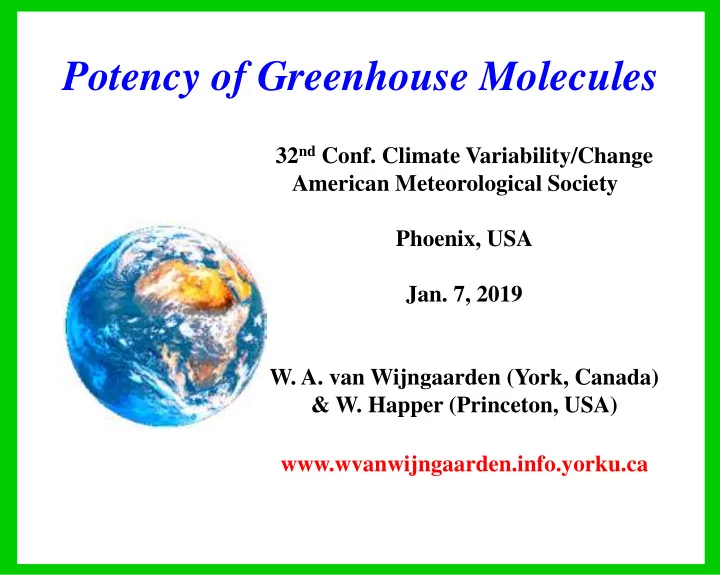

Potency of Greenhouse Molecules 32 nd Conf. Climate Variability/Change American Meteorological Society Phoenix, USA Jan. 7, 2019 W. A. van Wijngaarden (York, Canada) & W. Happer (Princeton, USA) www.wvanwijngaarden.info.yorku.ca
Greenhouse Gas Transitions Line Strengths from Hitran Database H 2 O N 2 O CH 4 CO 2 O 3
CO 2 Bending Mode at T = 300 K & P = 1 atm. • Atmosphere opaque at line center → global warming driven by far wings of lineshape • Far wings fall off faster than Voigt profile due to Dicke narrowing & collisions Voigt Lineshape Wing Suppressed Lineshape
Altitudinal Dependence Temperature Number Density McClatchey et al. Env. Res. Pap., AFCRL-782-0497 (1972)
Schwarzschild Equation S. Chandrasekhar, Radiative Transfer , Dover, New York (1960) Upward infrared heat intensity I( ν , z) at frequency ν & height z given by where attenuation CO 2 , N 2 O, CH 4 , H 2 O, O 3 Planck Brightness Stefan Boltzmann Law
Model Intensity Comparison to Satellite Data R. Hanel et al, Geophys. Res . 77 , 2629 (1972) • Intensity calculation for 1971 ambient levels of CO 2 , CH 4 , N 2 O & O 3 a) Sahara Model b) Sahara Observations --- B(320 K) H 2 O O 3 N 2 O, CH 4 H 2 O CO 2 c) Antarctica Model d) Antarctica observations --- B(190 K) CO 2
Upwards Flux at various Frequencies H 2 O CO 2 O 3 500.5 cm -1 667.4 cm -1 971 cm -1 1016.2 cm -1 ρ ∞ = 2.3 ρ ∞ = 51688 ρ ∞ = 0.033 ρ ∞ = 7.11 100 80 Altitude (km) 60 40 20 0 0.0 0.5 1.0 0.0 0.5 1.0 0.0 0.5 1.0 0.0 0.5 1.0
Radiative Forcing Fluxes computed for surface at 288.7 K & standard temperature profile • Standard Surface Levels: CO 2 (400 ppm), CH 4 (1.8 ppm ), N 2 O (0.32 ppm) • Standard Surface H 2 O (7750 ppm) varied ± 6% • O 3 (7.8 ppm at 35 km) kept constant • -- Doubled -- Standard -- Halved Altitude (km) -- Transparent Net Upwards Flux (W/m 2 )
Temperature Change due to Forcing Forcing: Δ Z = Z(Standard) – Z(Doubled) Δ T = Δ Z Temperature Increase: T 4 Z Top of Atmosphere Gas Concentration Change Forcing (W/m 2 ) +6% corresponding to 1 o C H 2 O 0.9 400 → 800 ppm CO 2 4.0 1.8 → 3.6 ppm CH 4 1.5 0.32 → 0.64 ppm N 2 O 2.2 O 3 No Change 5.3 Total All of above ⇒ Δ T = +1.4 o C Plus Clouds, Aerosols ????
Greenhouse Gas Potency P i (N i , N j ) = δ F / δ N i 10 Forcing Change (W/m 2 ) 0 -10 -20 H 2 O -30 CO 2 -40 O 3 N 2 O -50 CH 4 -60 -70 0 0.5 1 1.5 2 f = N i / N si Power per Molecule P i (N i , N j ) (10 -22 W) Gas Column Density (m -2 ) i P i (0, 0) P i (0, N s ) P i (N s , N s ) 4.67 x 10 26 2.5 x 10 -4 H 2 O 1.5 1.2 8.61 x 10 25 4.9 x 10 -4 CO 2 3.5 2.5 9.22 x 10 22 O 3 5.7 4.6 0.38 6.61 x 10 22 N 2 O 2.2 0.91 0.20 3.76 x 10 23 2.6 x 10 -2 CH 4 0.71 0.27
Conclusions 1. Radiative Forcing Doubling CO 2 , CH 4 , N 2 O & increasing H 2 O gives 5.3 W/m 2 forcing. 2. Temperature Increase Preceding forcing gives ∼ 1.5 o C temperature increase. This is crude estimate as it doesn’t consider changes in convection or clouds. 3. Greenhouse Potency • At very low concentrations, CO 2 , CH 4 , N 2 O & H 2 O have comparable forcings • At ambient levels CH 4 & N 2 O have greater per molecule forcing because CO 2 & H 2 O more strongly saturated due to 10 2 to 10 4 higher concentration More Info: www.wvanwijngaarden.info.yorku.ca
Recommend
More recommend